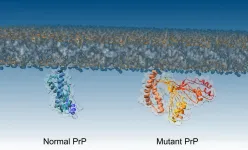(Press-News.org) An important Maya man buried nearly 1,300 years ago led a privileged yet difficult life. The man, a diplomat named Ajpach' Waal, suffered malnutrition or illness as a child, but as an adult he helped negotiate an alliance between two powerful dynasties that ultimately failed. The ensuing political instability left him in reduced economic circumstances, and he probably died in relative obscurity.
During excavations at El Palmar, a small plaza compound in Mexico near the borders of Belize and Guatemala, archaeologists led by Kenichiro Tsukamoto, an assistant professor of anthropology at UC Riverside, discovered a hieroglyph-adorned stairway leading up to a ceremonial platform. When deciphered, the hieroglyphs revealed that in June, 726 CE, Ajpach' Waal traveled and met the king of Copán, 350 miles away in Honduras, to forge an alliance with the king of Calakmul, near El Palmar.
The findings, published in the journal Latin American Antiquity, shed light on the role communities peripheral to major centers played in cementing connections between royal families during the Late Classic period (600-800 CE), and the ways they might suffer when something shattered those alliances.
The inscriptions identified Ajpach' Waal as a "lakam," or standard-bearer, an ambassador that carried a banner as they walked on diplomatic missions between cities. He inherited this lofty position through his father's lineage, and his mother also came from an elite family. Ajpach' Waal must have considered this his crowning achievement because the hieroglyphs indicate he was not given the platform by El Palmar's ruler, but had it built it for himself a few months after the mission in September, 726 CE. The platform served as a sort of theatrical stage where spectacular rituals were performed for an audience, with only influential people able to build their own.
Beneath the floor of a temple next to the platform, Tsukamoto discovered the undisturbed burial of a male skeleton in a small chamber. Though interred in a location that suggested ownership of the platform and temple, unlike other elite Maya burials, only two colorfully decorated clay pots -- no jewelry or other grave goods -- had accompanied this individual into the underworld.
In the new paper, Tsukamoto and Jessica I. Cerezo-Roma?n, an assistant professor of anthropology at the University of Oklahoma, study the bones of the person buried in this puzzling tomb to tell his story.
"His life is not like we expected based on the hieroglyphics," Tsukamoto said. "Many people say that the elite enjoyed their lives, but the story is usually more complex."
The man was between 35 and 50 years old when he died. Several dating methods, including radiocarbon, stratigraphy, and ceramic typology, suggest the burial occurred around 726, when the stairway was constructed. The high status of the individual combined with proximity to the stairway lead the authors to believe that this was probably Ajpach' Waal himself, or possibly his father.
All his upper front teeth, from right canine to left, had been drilled to hold decorative implants of pyrite and jade, which was valuable and highly regulated. Maya living in geographic areas associated with ruling elites underwent this painful procedure during puberty as a rite of passage to mark their inclusion within a high office or social group. Ajpach' Waal might have received such implants when he inherited his father's title.
The skull had been mildly flattened in back from prolonged contact with something flat during infancy, which the Maya believed made a person more attractive. Because the front of the cranium was not preserved, the archaeologists could not tell if the forehead had been similarly flattened, a beautification practice limited to royalty.
Other aspects of the bones belied the privilege displayed by the dental and cranial modifications. Some of his arm bones had healed periostitis, caused by bacterial infections, trauma, scurvy, or rickets, which would have made his arm ache until the condition improved. Both sides of the skull had slightly porous, spongy areas known as porotic hyperostosis, caused by childhood nutritional deficiencies or illnesses. The condition is relatively common in burials throughout the Maya world, suggesting Ajpach' Waal's high status couldn't shield him from malnutrition and disease.
A healed fracture on his right tibia, or shinbone, resembles fractures seen in modern athletes who play contact sports such as football, rugby, or soccer. This could indicate he played some of the ballgames depicted on the stairway, strengthening the case that this was Ajpach' Waal.
Long before he died, the individual had lost many teeth on the left side of his lower jaw due to gum disease and might have had a painful abscess on his lower right premolar, all of which would have restricted his diet to soft foods. One inlaid tooth had thickened near the root in response to the injury of drilling and could have ached.
He also developed arthritis in his hands, right elbow, left knee, left ankle, and feet as he aged, which would have caused stiffness and pain, especially in the morning. Tsukamoto and Cerezo-Roma?n suggest that his arthritis might have been caused by carrying a banner on a pole for long distances over rugged terrain and walking and up and down stairways. He would have also been required to kneel on the platforms of Maya rulers.
As if these maladies weren't enough, fate conspired to change Ajpach' Waal's fortunes.
"The ruler of a subordinate dynasty decapitated Copán's king 10 years after his alliance with Calakmul, which was also defeated by a rival dynasty around the same time," Tsukamoto said. "We see the political and economic instability that followed both these events in the sparse burial and in one of the inlaid teeth."
The archaeologists determined that the inlay in Ajpach' Waal's right canine tooth had fallen out and was not replaced before his death because dental plaque had hardened into calculus in the cavity. The hole, easily visible when the man smiled or spoke, would have been an embarrassing, public admission of hardship or El Palmar's reduced significance. This also would have made him a less useful emissary if he still occupied the role.
Though people continued living at El Palmar for some time after Ajpach' Waal's death, it was eventually abandoned and reclaimed by the jungle.
INFORMATION:
The paper, "The Life Course of a Standard-Bearer: A Nonroyal Elite Burial at the Maya Archaeological Site of El Palmar, Mexico," is available here.
(Boston)-- Newly published National Institute of Neurological Disorders and Stroke (NINDS) Consensus Diagnostic Criteria for Traumatic Encephalopathy Syndrome (TES) are the first expert consensus criteria developed for the clinical disorder associated with Chronic Traumatic Encephalopathy (CTE) brain pathology. CTE is a degenerative brain disease associated with a history of repetitive head impacts, including those sustained in contact and collision sports such as American football and boxing. At this time, CTE can only be diagnosed after death through a neuropathological examination of brain tissue. There has been no accepted approach or agreed upon criteria for the diagnosis of CTE and its clinical manifestations during life until now.
"The publication of these criteria ...
Exercise during pregnancy may let mothers significantly reduce their children's chances of developing diabetes and other metabolic diseases later in life, new research suggests.
A study in lab mice has found that maternal exercise during pregnancy prevented the transmission of metabolic diseases from an obese parent - either mother or father - to child. If the finding holds true in humans, it will have "huge implications" for helping pregnant women ensure their children live the healthiest lives possible, the researchers report in a new scientific paper.
This means that one day soon, a woman's first trip to the doctor after conceiving might include a prescription for an exercise ...
The $1.9 trillion American Rescue Plan, a stimulus package introduced by the Biden Administration, recently received Congress' approval. The stimulus package, like its two predecessors aimed at providing relief for individuals and businesses hindered by the COVID-19 pandemic, includes another round of funding for the Paycheck Protection Program (PPP).
The American Rescue Plan includes $7.25 billion for PPP loans as well as a number of changes to make it easier for the smallest of businesses to gain access to the funding. With billions on the table for struggling small businesses, new research from the University of Florida Warrington College of ...
How important is fame? What about self-acceptance? Benevolence? The messages children between the ages of 8 and 12 glean from TV play a significant role in their development, influencing attitudes and behaviors as they grow into their teenage years and beyond, UCLA psychologists say.
Now, a new report by UCLA's Center for Scholars and Storytellers assesses the values emphasized by television programs popular with tweens over each decade from 1967 to 2017, charting how 16 values have waxed and waned in importance during that 50-year span.
Among the key findings is that fame, after nearly 40 years of ranking near the bottom (it was 15th in 1967, 1987 and 1997), rose to become the No. 1 ...
Louisiana State University researchers recently published findings that blight leads to an increased abundance of disease-carrying mosquitoes. The researchers investigated the presence of several mosquito species in two adjacent but socio-economically contrasting neighborhoods in Baton Rouge: the historic Garden District, a high-income neighborhood, and the Old South neighborhood, a low-income area. They found significantly higher adult and larvae abundance of the Asian tiger mosquito (a carrier of Zika and dengue) and higher mosquito habitat availability--particularly discarded tires--in the Old South neighborhood. This indicates that environmental conditions in the low-income neighborhood were most ideal for this mosquito to breed and proliferate.
"These ...
Some invasive species targeted for total eradication bounce back with a vengeance, especially in aquatic systems, finds a study led by the University of California, Davis.
The study, published today in the journal PNAS, chronicles the effort --and failure -- to eradicate invasive European green crabs from a California estuary. The crabs increased 30-fold after about 90 percent had been removed. The study is the first experimental demonstration in a coastal ecosystem of a dramatic population increase in response to full eradication.
"A failure in science often leads to ...
The world's oceans are a vast repository for gases including ozone-depleting chlorofluorocarbons, or CFCs. They absorb these gases from the atmosphere and draw them down to the deep, where they can remain sequestered for centuries and more.
Marine CFCs have long been used as tracers to study ocean currents, but their impact on atmospheric concentrations was assumed to be negligible. Now, MIT researchers have found the oceanic fluxes of at least one type of CFC, known as CFC-11, do in fact affect atmospheric concentrations. In a study appearing today in the Proceedings of the National Academy of Sciences, the team reports that the global ocean will reverse its longtime role as a sink for the potent ozone-depleting chemical.
The researchers ...
In 1966, US Army scientists drilled down through nearly a mile of ice in northwestern Greenland--and pulled up a fifteen-foot-long tube of dirt from the bottom. Then this frozen sediment was lost in a freezer for decades. It was accidentally rediscovered in 2017.
In 2019, University of Vermont scientist Andrew Christ looked at it through his microscope--and couldn't believe what he was seeing: twigs and leaves instead of just sand and rock. That suggested that the ice was gone in the recent geologic past--and that a vegetated landscape, perhaps a boreal forest, stood where a mile-deep ice sheet as big ...
For the first time, researchers have pinpointed what causes normal proteins to convert to a diseased form, causing conditions like CJD and Kuru.
The research team, from Imperial College London and the University of Zurich, also tested a way to block the process, which could lead to new drugs for combatting these diseases.
The research concerned prion diseases - a group of brain diseases caused by proteins called prions that malfunction and 'misfold', turning into a form that can accumulate and kill brain cells. These diseases can take decades to manifest, but are then are aggressive and fatal.
They include Kuru, mad cow disease and its human equivalent Creutzfeldt-Jakob disease (CJD), and a heritable condition called fatal familial ...
If you live in a flood prone area, would you -- or could you -- take measures to mitigate flood risks? What about others in your community? We are running out of time to ask this question according to The World Resources Institute, because global flood risk is increasing and loss projections for rivers alone put the cost over 500 billion dollars by midcentury.
Research published today in Proceedings of the National Academy of Sciences from scientists from the University of Connecticut, the University of Maryland's National Socio-Environmental Synthesis Center (SESYNC), the University of Massachusetts Amherst, and the London School of Economics suggests that in the United States, race and stream flow are ...





